ISSN: 2339-076X (p); 2502-2458 (e)
,
Volume 3, Number 4 (July 2016): 617-623
DOI:10.15243/jdmlm.2016.034.617
Review
A brief history of the development of blasting and the modern theory
of rock breaking
A.K. Kirsanov
*, S.A. Vokhmin, G.S. Kurchin
Siberian Federal University, Krasnoyarsk, 660025, Russia.
* corresponding author: [email protected]
Abstract
: The article is devoted to the task today to improve the effectiveness of blasting during construction of horizontal and inclined mine excavations. Construction of new and reconstruction of existing mines requires large volume of excavation works, which length can reach tens of kilometers for only one project. Drilling and blasting workings allow not only to break out rocks from a frontal part of an excavation, but also cause an internal effect, which can lead to undesired damage that, in turn, often lead to increased expenses for excavation operations and safety problems for personnel. Calculation methods for blasting and explosion operations is a topical issue in mining industry as they allow to improve characteristics of excavation works and safety of explosion operations. Dozens of scientists offer their design, which reflects the vision of the problem and its solution. There are many methods for calculating the parameters of drilling and blasting, but so far not developed a uniform methodology of calculation, which would encompass all the factors and explained the mechanism of formation of cracks around the explosive charge and the process of breaking rock. The paper presents a novel methodology for calculations for blasting and explosion operations. That methodology comprises various specifics of rock geology and mining engineering during works in horizontal and vertical excavations. In this paper given an algorithm for calculation two main areas of destruction: crushed zone and fracturing zone. In addition, article outlines main aspects of Mining Engineering Development from Antiquity until present days and presents the dynamic of mineral resources.Keywords:calculation methodology, crushed zon, explosive,fracturing zone, the history of mining
Introduction
From ancient times onwards, all great civilizations dazzled the descendants with tremendous construction projects that did not make real without unfree labour. Throughout history, mankind have created many great architectural masterpieces, some of the most ancient ones are known as Wonders of the World (the Great Pyramid of Giza, Hanging Gardens, Temple of Artemis in Ephesus, Statue of Zeus in Olympia, Mausoleum in Halicarnassus, Colossus of Rhodes, Lighthouse of Alexandria) and others, which have been built at present times, (Taj Mahal, Eifel Tower, Sydney Opera House, Statue of Christ the Redeemer etc.) that are also considered as Modern Wonders of the World by some scholars.
Nevertheless, none of these masterpieces could have been raised without construction
materials, mined in pits and mines from time immemorial. Mining can be considered as economic fundamental of human activity. Any developed country pays much attention to this aspect for the state of mining industry and amount of mineral resources production define power and wealth of a country. Development of earlier civilizations started with and was accompanied by exploration, excavation and production of specific materials.
gold and quartz rock. Although the original text was lost and never found, his mines description was preserved by another Greek historian Diodorus who quoted it. Egyptian method was as follows: rock was first cracked and broken with fire, then the debris were crushed with pickaxes and hammers. After that, rock fragments were taken out of mine and pounded in huge stone mortars to the size of a pea, then grinded into powder in hand mills. This powder was later washed on inclined planes to separate metal grains. The grains were melted and run into small ingots afterwards (Lucas, 1958).
The main mining centre of ancient Greece was Lavrio, where about 490 year B.C. achievements in mining encouraged Athens to turn into a naval power and strengthen the City States’s defense power in war against Persia. This increase in extraction of minerals was due to vast amount of slaves. Later, many of them managed to escape during Peloponessian War in 413, and then the restoration of Lavrion deposit in 4th century B.C. was hard and took a long time (Electronic resource: History of Ancient World).
Development of mining engineering in Macedonia, commenced about 350 B.C. in mines near Philipp, resulted in dramatic drop of ore mining in Greece in 3rdcentury B.C. Things were worsen by the fact that thin copper ore beds near Corinth and Euboea were exhausted long time ago. The primary and most widespread way of mining was laying many narrow adits (1.5x2 metres) with short subsurface drifts. Special narrow air drifts 50x50 cm size was made for ventilation. Ore excavation was manual and slave labour predominated (Electronic resource: History of Ancient World).
In ancient Rome, a 6-kilometre adit was built to discharge water from Turchino lake. The drainage was carried by two counter headways having 40 vertical and 70 inclined shafts, dug along the adit axis (Apostol, 2004).
In 6thcentury B.C. on the island of Samos in Greece 1036 metre long Evpalinos Tunnel was built with simple hammers, pickaxes and chisels. At that time, Samos was under the reign of Polycrates. During his rule two teams of workers under tenure of engineer, Evpalinos dug a tunnel under Mount Castro which transported fresh water for ancient Samos capital Pythagoreo. This tunnel also served a defense purpose, because an underground aqueduct was not easily found by enemy and cut. Archeological survey showed that Evpalinos Tunnel had been used for a thousand years, and it was the second known tunnel built from both ends. Today it has become a popular tourist attraction (Electronic resource: Meander
Travel; Meyers and Shanley, 1990; Apostol, 2004; Agrawal, 2010).
Therefore, we can conclude that formation of human society was directly connected to development of mining engineering. Purposeful mining development dates back to the Stone Age and initially was held with stone tools. Improving those tools gradually, mankind passed Copper, Bronze and then Iron Age. Iron hammers, pickaxes and other tools had been major instruments of mining production, which also allowed increasing work force productivity greatly.
Discovery and use explosives in mining
works
Gunpowder and dynamite
A new period in mining engineering and in human history begins after discovery of an explosive – gunpowder. The first explosive used for military purpose and in different sectors of economy was gunpowder (also known as black powder), which was a mixture of sulfur, charcoal and potassium nitrate (saltpetre) in different proportions. Discovery of gunpowder descends to great antiquity. Gunpowder like explosives is believed to be known many years before Christ in China and India, where saltpetre naturally release from the soil. It is clear that people of these two countries can have discovered easily the explosive properties of saltpetre and its mixture with charcoal, and then used this mixture for various purposes (Kutuzov, 2008).
Chinese scientists found documents, which prove that China was the first country, invented gunpowder. According to Professor Feng Jiasheng of Central University of Nationalities, Peoples Republic of China (Peoples China Journal, 1956), on the cusp of 5th and 6th century’s Chinese medical practitioner Tao Hongjing studied saltpetre combustion. However, Chinese learned how to make gunpowder from a mixture of saltpetre, sulfur and charcoal only three of four centuries later.
Information about gunpowder was likely to reach Arabs and Greeks and then got to Europe.
Replacement of gunpowder with stronger dynamite, patented by Alfred Nobel in 1867, was of paramount importance for mining engineering development.
Comparatively incompetent formations, some kinds of bituminous coal for example, can be mined with a coal pick. Excavation of harder rock requires more substantial impact, achieved by means of blast energy (Andreev, 1956).
Development of blasting work
Development of blasting work as an engineering tool for practical exploration of mineral resource deposits dates back to Hungarian Pits of the beginning of 1527 (Sukharevsky, 1923)
However, even hundred years after there are yet many challenges to face in this sphere of mining engineering. On the other hand, there are a various fields of blasting engineering, where researchers develop new explosives, new theories of blast destruction of rock, blast holes arrangement, blast work technologies etc.
One of the results of blasting engineering development is that it has evolved various methods of analysis for drilling and blasting parameters at underground mine construction. Basing on these researches, leading scientists all over the world suggest their methodic, which take
into consideration geological and mining conditions (Szuladzinski, 1993; Djordjevic, 1999; Esen et al., 2003; Vokhmin et al., 2014; Kurchin et al., 2015).
As a number of scientists (Kutuzov and Andrievsky, 2002; Viktorov and Zakalinsky, 2010; Vokhmin et al., 2015) believe that in the foreseeable future blasting will become the only comprehensive and most efficient way of rock fragmentation, great attention should be paid to development of the most optimum drilling and blasting parameters.
Figure 1 shows the dynamic of mineral recourses and materials production (mineral fuel, iron and ferrous alloys, non-ferrous metals, precious metals, construction materials like non-metallic mineral recourses) for 1984 onwards (Reichl et al., 2015). Rate of increase for these 29 years is about 50 per cent. Half of the mined solid minerals is explored with the use of blast energy, while general consumption of explosives is millions of tons per year according to assessment and has a clearly defined tendency to grow.
Figure 1. World production of mineral recourses for 1984 – 2013
Currently there are about 168 countries in the world where mining is being carried. Figure 2 and 3 present the leading countries in amount of
Figure 2. World leaders in mineral recourses mining
Figure 3. World leaders in income on sales of mineral recourses
Gradation of these countries in the graphics differs a bit. Also they illustrate that first 3 countries (China, the USA and Russia) together mine a little more than 50 per cents of mineral recourses, and this makes much difference to their financial results.
The calculation of fracture zones of rock
mass around an explosive charge
The problem and the formulation of the problem
Underground excavation method is often preferred among other methods for development of minerals' deposits. Construction of new and reconstruction of existing mines requires large volume of excavation works, which length can reach tens of kilometers for only one project.
Drilling and blasting workings allow not only to break out rocks from a frontal part of an excavation, but also cause an internal effect, which can lead to undesired damage that, in turn, often lead to increased expenses for excavation operations and safety problems for personnel.
Nowadays, in order to decrease undesired internal damage and predict that damage during drilling and blasting workings many methodologies are developed, which are based on definition of rock massif destruction zones'
parameters of during explosion of explosives charge. The paper presents a novel methodology for calculations for blasting.
The proposed methodology
In a case of explosion of elongated explosive charge in rock, massif different researchers specify 2-3 main distinguished destruction zones (Figure 4). (Mоsinets and Gоrbасhevа,1972;
Szulаdzinski, 1993; Djоrdjeviс,1999; Kutuzov and Andrievsky, 2002; Rakishev, 2010):
1. Crushing zone (crumple crushing, compression, impact zone, zone of fine fragmentation);
2. one (zone of radial cracks);
3. Zone of elastic deformation (seismic zone).
Figure 4. Scheme of formation of crushed and fracturing zone
The proposed methodology for definition of blasting parameters is based on reliable definition
of radii of those two zones; it implies the following course of calculations:
Calculation crushed zone:
Whered – blasthole diameter, m; ρ – density of ES in charge, kg/m3; f – strength coefficient of rocks according to scale of M.M. Protod'yakonov.
Calculation fractured zone:
Graphical representation of drilling and blasting passport
Creation of a graphical representation of frontal projection of drilling and blasting passport begins from placement of outlining blastholes. For that, at distanceRcrfrom an excavation's outline a point for a first blasthole is defined. After that, a distanceRcrfrom a design outline along a whole perimeter of an excavation other outlining blastholes are placed. Distance between outlining blastholes is defined using value of fracturing zone Rfr. Distance between outlining and first row of auxiliary blastholes is defined by value of the
line of least resistance. Taking into account those parameters location of outlining and auxiliary blastholes along a whole cross-section of an excavation is defined (Figure 5).
If number of blastholes after their placement is not integer, its value is rounded to the nearest integer value and distance between blastholes is calculated again in way that distances between outlining blastholes working in the same conditions were equal. Change of distance as compared with a calculated parameter must not exceed ±10%.
Figure 5. The scheme of arrangement blastholes in the mine
Conclusion
Judging by the dynamics of mining production growth, demand for all kinds of mineral materials is growing constantly. This demand results from the strategy of country long-term economic development, which is ensured by comprehensive exploration of deposits. Increasing mining depth and worsening of mining and geological
main points, determining rock fragmentation efficiency.
However, there is no universal analysis method, which could cover all factors and explain mechanism of crack formation around exploded charge.
The proposed methodology for calculation of blasting parameters considers main rock geology and rock engineering factors, which influence efficiency of drilling and blasting during construction of excavations. The methodology past trials at 8 underground mining facilities of "Norilsk nickel" ltd. arctic branch and demonstrated high efficiency, which was proved by decrease of consumption of explosive and volume of drilling works.
Acknowledgments
Researchers work in this sphere in the frame of the Grand of Russian Federation President for State Support of Young Russian Scientists – Candidates of Science – MK-5475.2015.8
References
Agrawal, J.P. 2010. High Energy Materials, Propellants, Explosives and Pyrotechnics. Wiley-VCH Verlag GmbH & Co. KGaA, Weinheim, Germany, 464 pp. Andreev, K.K. 1956. Explosion and Explosive
Materials. Military Publishing House of USSR Ministry of Defense, Moscow.
Apostol, T.M. 2004. The tunnel of Samos.Engineering and Science1: 30-40.
Djordjevic, N. 1999. Two-component of blast fragmentation. Proceedings of the Sixth International Symposium on Rock Fragmentation by Blasting-Fragblast, South African Institute of Mining and Metallurgy, Johannesburg, South Africa, p. 213–9.
Esen, S., Onederra, I. and Bilgin, H.A. 2003. Modelling the size of the crushed zone around a blasthole. International Journal of Rock Mechanics and Mining Sciences40: 485–495.
History of Ancient World: Dictionary of Antique World. Mining Engineering. Available online at: http://ancientrome.ru/dictio/article.htm?a=1692273 44 (accessed on: 05. September 2015).
Kurchin, G.S., Vokhmin, S.A., Kirsanov, A.K., Shigin, A.O. and Shigina, A.A. 2015. Calculation methodology of blasting and explosion operations' parameters for construction of horizontal and inclined excavations. International Journal of Applied Engineering Research 10 (15) : 35897-35906.
Kutuzov, B. 2007. Methodology of explosive operation. Part 1. Destruction of rocks by means of explosion. Moscow: Mining literature, 471 P.
Kutuzov, B.N. 2008. History of Mining and Blasting Engineering: Textbook for Higher Educational Institutions. Moscow: Moscow State Mining University Press, Mining Book Publishing House, 414 p.
Kutuzov, B.N. and Andrievsky, A.P. 2002. New Theory and New Technologies of Rock Destruction by Linear Charges of Explosives. Novosibirsk: Science, 96 p.
Lucas, A. 1958. Ancient Egyptian Materials and Industries. Moscow: Foreign Literature Press, 407 p. Meander Travel: Evpalinos Tunnel on Samos.
Available online at:
http://www.meandertravel.com/samos/samos.php?d etails=efpalinustunnelofsamos&m=1&md=sc1 (accessed on: 16. October 2015)
Meyers, S. and Shanley, E.S. 1990. Industrial explosives - a brief history of their development and use.Journal of Hazardous Materials23 (2) : 183– 201.
Mosinets, V. and Gorbacheva, N. 1972. A seismological method of determining the parameters of the zones of deformation of rock by blasting.Soviet Mining Science 8(6) : 640-647. Peoples China Journal. 1956. No14, pp.37-40.
Rakishev, B. 2010. Definition of sizes of destruction zones in a rock massif in a case of borehole crushing explosive charge. Explosion Engineering103 (60) : 53-65.
Reichl, C., Schatz, M. and Zsak, G. 2015. World Mining Data. Volume 30. Mineral Production. Vienna, 261 p.
Sukharevsky, M. 1923. Explosives and Blast Works. Manual for Engineers, Technicians and Students. State Engineering Press. Moscow, Vol. 1. 32 p. Szuladzinski, G. 1993. Response of rock medium to
explosive borehole pressure. Proceedings of the Fourth International Symposium on Rock Fragmentation by Blasting-Fragblast-4, Vienna, Austria, p. 17–23.
Viktorov, S.D. and Zakalinsky, V.M. 2010. Strategy of blasting engineering effective development in Russia.Mining Journal 4 : 56-59.
Vokhmin, S.A., Kurchin, G.S., Kirsanov, A.K. and Deryagin, P.A. 2014. Calculation of parameters of drilling and blasting operations for horizontal and inclined working. Nosov Magnitogorsk State Technical University Reporter 4 (48) : 5-9. Vokhmin, S.A., Kurchin, G.S., Kirsanov, A.K. and
Gribanova D.A. 2015. The calculation of construction straight prismatic cut. Modern Issues of Education and Science. No 1. Available online at: http://www.science-education.ru/121-17267 (accessed on: 16. October 2015).



